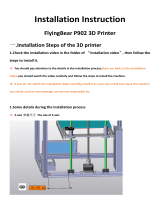
Contents
CONTENTS
ABOUT THE MANUAL ..................................................................................................................................... 5
ABBREVIATIONS AND DEFINITIONS ......................................................................................................... 5
1 INTRODUCTION TO SOFTPLC ................................................................................................................ 6
1.1 SYMBOL OF THE DATA TYPES ....................................................................................................... 6
2 SOFTPLC MEMORY ................................................................................................................................. 7
2.1 MEMORY ............................................................................................................................................ 7
2.2 DATA MEMORY ................................................................................................................................. 7
2.2.1 Constants.................................................................................................................................... 7
2.2.2 Physical Inputs and Outputs (Hardware) ................................................................................. 7
2.2.3 Volatile Markers (Variables) ...................................................................................................... 8
2.2.4 System Markers ......................................................................................................................... 8
2.2.5 Parameters ............................................................................................................................... 10
2.3 MODBUS .......................................................................................................................................... 11
2.3.1 Modbus protocol SoftPLC addresses ................................................................................... 11
2.3.2 Protocol..................................................................................................................................... 11
3 RESUME OF THE FUNCTION BLOCKS ................................................................................................ 12
3.1 CONTACTS ...................................................................................................................................... 12
3.1.1 Normally Open Contact – NO CONTACT ............................................................................... 12
3.1.2 Normally Closed Contact – NC CONTACT ............................................................................ 12
3.1.3 “AND” Logic with Contacts .................................................................................................... 12
3.1.4 “OR” Logic with Contacts ....................................................................................................... 12
3.2 COILS ............................................................................................................................................... 13
3.2.1 Normal Coil - COIL ................................................................................................................... 13
3.2.2 Negated Coil – NEG COIL........................................................................................................ 13
3.2.3 Set Coil – SET COIL ................................................................................................................. 13
3.2.4 Reset Coil – RESET COIL ........................................................................................................ 13
3.2.5 Positive Transition Coil – PTS COIL ....................................................................................... 13
3.2.6 Negative Transition Coil – NTS COIL ..................................................................................... 13
3.3 MOVEMENT BLOCKS ..................................................................................................................... 13
3.3.1 Speed and/or Torque Reference – REF ................................................................................. 13
3.4 PLC BLOCKS ................................................................................................................................... 14
3.4.1 Timer – TON .............................................................................................................................. 14
3.4.2 Incremental Counter – CTU .................................................................................................... 14
3.4.3 Proportional-Integral-Derivative Controller – PID ................................................................ 14
3.4.4 Low-pass or High-pass Filter – FILTER ................................................................................. 15
3.5 CALCULATION BLOCKS ................................................................................................................ 15
3.5.1 Comparator – COMP ............................................................................................................... 15
3.5.2 Math Operation – MATH .......................................................................................................... 15
3.5.3 Math Function – FUNC ............................................................................................................ 16
3.5.4 Saturator – SAT ........................................................................................................................ 16
3.6 TRANSFER BLOCKS ....................................................................................................................... 17
3.6.1 Data Transfer – TRANSFER .................................................................................................... 17
3.6.2 Conversion from Integer (16 bits) to Floating Point – INT2FL ............................................. 17
3.6.3 User Fault or Alarm Generator - USERERR .......................................................................... 17
3.6.4 Convert from Floating Point to Integer (16 bits) – FL2INT ................................................... 17
3.6.5 Indirect Data Transfer – IDATA ............................................................................................... 18
3.6.6 Multiplexer – MUX .................................................................................................................... 18
3.6.7 Demultiplexer – DMUX ............................................................................................................ 19
4 INVERTER PARAMETER SETTINGS ..................................................................................................... 20
4.1 SYMBOLS FOR PROPERTY DESCRIPTION ................................................................................. 20
4.2 CFW100 CONFIGURATION PARAMETERS .................................................................................. 20
4.3 EXCLUSIVE SOFTPLC PARAMETERS .......................................................................................... 21
CFW100 | 3





















